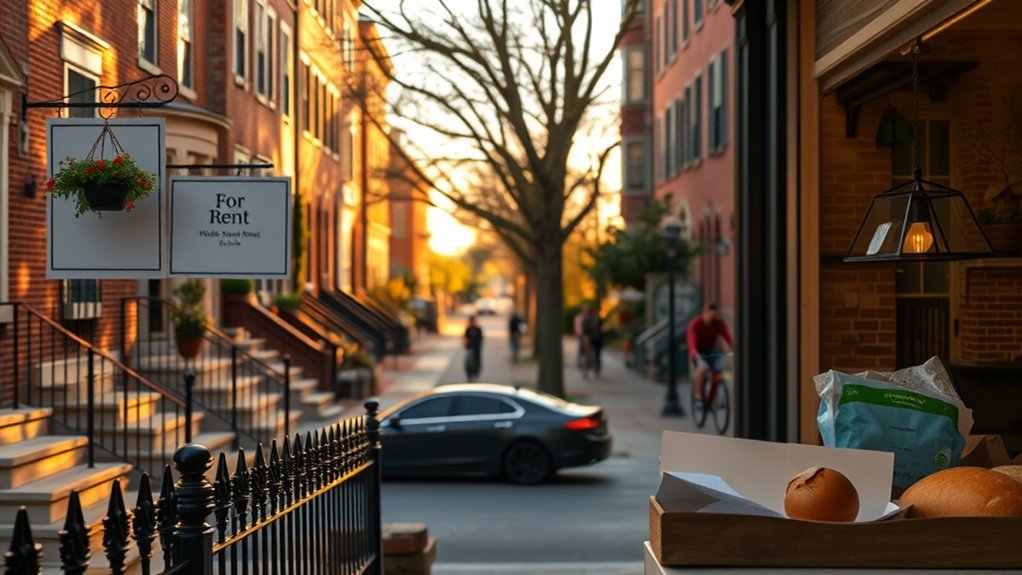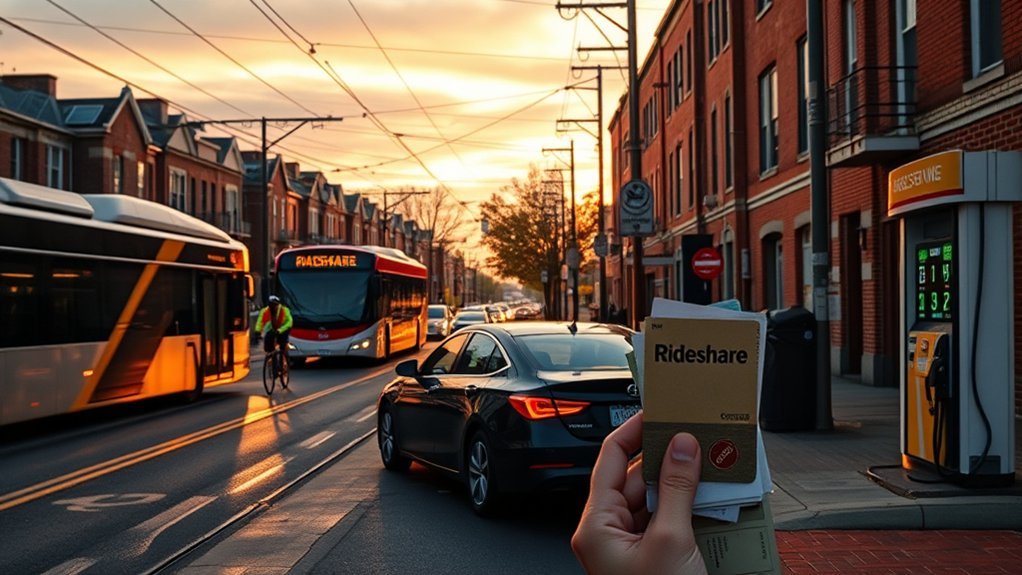You’ll need roughly $4,600–$5,500 a month to cover typical Norfolk costs: one‑bed rent about $1,316, utilities $250–$390, groceries ~$300–$681, and transport $60–$200 plus occasional fuel. Homeowner costs and healthcare run higher — median home near $393K and medical bills above national average. Internet and phone usually add $55–$125 monthly. This gives a practical starting budget and if you keep going you’ll find detailed breakdowns and tips to refine it.
Housing and Average Rent in Norfolk

Affordability shapes housing in Norfolk: average apartment rent sits around $1,315–$1,316 per month—about 19–24% below the U.S. average of $1,629—while typical unit rents are roughly $1,349 for a studio, $1,316 for a one‑bed, $1,453 for a two‑bed, and $1,856+ for a three‑bed (average apartment ~669 sq ft).
Norfolk stays affordable: average rents ~ $1,315–$1,316, compact units (~669 sq ft) and lower-than-national pricing.
You’ll find the average rent in Norfolk remains competitive versus national figures, and apartment sizes skew compact. Use the CoStar market trend to track the 3.1% year-over-year rent change, roughly a $41 monthly rise, when planning your budget.
If you aim to follow the 30% rent-to-income guideline, an average monthly income near $4,386 (about $52,632/year) is needed to afford the typical one‑bedroom apartment without stretching finances.
For ownership comparison, the median home price (average listing) sits around $392,786, about 24% below the national median, informing decisions between renting and buying as part of overall housing costs. Additionally, understanding construction costs can provide insights for those considering building their own home in the area.
Monthly Utilities and Internet Costs

Expect average utilities around $250/month for a ~915 sq ft apartment, with energy costs about 8% higher than the U.S. average (energy bills ≈ $225). Internet plans (60 Mbps+) run $40–$100/month, typically $60–$80, and phone service averages about $188.39/year. Factor in higher summer cooling costs and consider efficient appliances and insulation to trim bills. Regular inspections of your air conditioning system can help prevent issues and maintain optimal performance during the hotter months, which is essential for air conditioning function.
Typical Monthly Utility Bills
Typically, you’ll pay around $225 a month for energy in Norfolk, with overall utilities running about 4% above the U.S. average. You should budget for higher seasonal energy use: hot summers push cooling consumption and air conditioning costs roughly 8% above national energy figures. For an ~85 m² (915 sq ft) apartment, expect a monthly utility bill between $75.72 and $232, while Virginia averages hover near $250 for similar units. Owners often see larger bundled totals.
- Small apartment baseline: ~$76–$232/month utilities
- Typical energy costs: ~$225/month (electricity/heat)
- Internet cost range: $40–$100/month (local typical)
- Phone service: about $188.39/year (near utility averages)
Internet and Phone Plans
When planning monthly bills in Norfolk, factor about $40–$100 for a 60 Mbps+ internet plan and roughly $15.70/month for phone service (about $188.39/year), with faster speeds or bundles pushing internet toward $100.
You’ll find typical internet prices for 60 Mbps often fall $40–$76 depending on neighborhood; fiber or bundled packages raise monthly internet cost. For cell phone service, compare carriers and family plans — phone plans and bundles can trim telecom expenses.
Include these telecom expenses in your utilities budget: estimate $40–$100 for internet plus $15–$25 for basic cell phone service, then add $75–$250 for combined utilities depending on apartment size and usage.
That keeps your monthly utilities and telecom costs realistic for Norfolk.
Seasonal Energy Costs
Often you’ll see Norfolk’s monthly utility bills climb and fall with the seasons: average energy costs run about $224.88/month (roughly 8% above the national average), driving typical utility ranges from about $75.72 to $232 for an 85 m² (≈915 sq ft) apartment depending on summer cooling or milder winter heating needs.
You should plan for seasonal energy use that pushes summer electricity and air conditioning expenses higher, while heating costs stay moderate.
Monthly utilities including water and garbage average near $250 for renters; homeowners face a larger homeowner utility burden and can see energy bills spike much more.
Visualize cost drivers:
- Summer: peak cooling costs, higher air conditioning expenses.
- Winter: moderate heating costs.
- Internet/phone: $40–$100 + $188/yr.
- Homeowner: elevated utility line-items.
Grocery, Food and Everyday Essentials

You’ll find groceries in Norfolk are about 1.6% cheaper than the U.S. average, with common items like steak at $15.61, ground beef $6.94, and a dozen eggs $3.64.
Expect a single adult’s annual groceries near $8,172 (roughly $681/month), though many people spend $300–$400 monthly depending on habits.
Eating out is affordable too, with cheap meals around $12 and a mid‑range three‑course dinner for two near $50, so occasional dining can fit a modest budget. Additionally, regular maintenance on your vehicle can help prevent costly repairs later on, such as those associated with exhaust leaks.
Typical Grocery Costs
Typically, groceries in Norfolk cost slightly less than the national average — about 1.6% lower — so you’ll see common items like a pound of ground beef at $6.94 and a dozen eggs at $3.64.
You can plan monthly grocery spending around $681 for a single adult or roughly $400–$600 for family of four groceries, depending on choices.
Food prices for staples vary: bananas $0.74/lb, steak $15.61/lb, potatoes $4.88/package. Shop at local grocery retailers like Food Lion, Walmart Supercenter, and Kroger to keep your weekly grocery budget reasonable.
- Ground beef price: $6.94/lb
- Dozen eggs cost: $3.64
- Single adult food cost: ~$681/month
- Family grocery range: $400–$600/month
Eating Out Expenses
Frequently, eating out and buying everyday essentials in Norfolk costs less than in many U.S. cities, so you can expect an inexpensive meal at a casual restaurant to run about $12 and a mid-range three-course dinner for two to be roughly $50; groceries are also modestly cheaper (about 1.6% below the national average) with common items such as ground beef at $6.94/lb and a dozen eggs at $3.64, and household goods and services running about 4.1% below the U.S. average, which helps keep overall food-related spending reasonable. You’ll find cheap eats for quick lunches, affordable dining for weekends, and mid-range restaurant options without a steep restaurant meal price premium.
| Item | Typical Price | Notes |
|---|---|---|
| Inexpensive meal | $12 | average meal cost |
| Three-course meal for two | $50 | mid-range restaurant |
| Cinema and dining | $10–$12.56 | combined outing cost |
Transportation and Commuting Expenses

Getting around Norfolk won’t break the bank if you plan smart: local one-way transit fares run about $2.00 and an HRT monthly pass is commonly near $60, while driving tends to be pricier once you factor in fuel (around $3.11/gal), insurance (≈$1,200/year), maintenance, and parking.
Getting around Norfolk is affordable if you plan: $2 one-way fares, ~$60 monthly pass, driving costs add up.
You’ll find transportation costs here sit about 4.1% below the U.S. average, but your commuting expenses depend on mode. A single adult’s typical annual transport spend is roughly $9,985, so compare options.
- Take HRT buses and light rail: lower fixed costs with a public transit monthly pass.
- Drive alone: gasoline per gallon and vehicle maintenance add up fast.
- Carpool or ferry: cuts fuel prices and parking costs per person.
- Budget insurance and occasional repairs: car insurance averages near $1,200/year.
Additionally, understanding traffic lawyer costs may provide insight into potential legal expenses if you face a traffic violation while commuting.
Use the data to pick transit fare vs. driving; public transit or carpooling usually yields the best monthly savings.
Healthcare, Childcare and Education Costs

After you’ve weighed your transit choices, it’s important to account for healthcare and family costs, which push Norfolk’s budget higher in other areas. Healthcare costs run about 10.3% above the U.S. average: expect a typical doctor visit cost near $146.25 and a dentist visit cost around $150.15.
A single adult’s annual medical cost is roughly $3,127; family healthcare expenses for a family of four average about $9,609 yearly.
Health insurance premiums commonly range $300–$500 per month depending on age and coverage, and out-of-pocket medical expenses (copays, deductibles, prescriptions) vary by plan. Childcare costs are substantial: monthly preschool tuition typically falls between $800 and $1,800 per child.
If you’re considering private options, private school tuition runs roughly $15,316–$22,000 annually for primary grades. Combined childcare and higher local healthcare explain why a married couple with young children faces basic expenses near $7,229/month, about 5.7% below the national average overall.
Suggested Livable Salary and Sample Monthly Budget

Because Norfolk’s overall cost of living sits about 6.3% below the national average but has higher healthcare and utility costs, a practical target for a single adult is roughly $55,416 per year before taxes.
You can use that suggested livable salary to build a realistic monthly budget that reflects Norfolk cost of living trade-offs.
With average rent near $1,315–$1,316, the 30% rent guideline implies about $4,386/month income. Typical renter monthly budget items look like:
- Housing costs (rent + insurance): ~$1,989
- Utilities: ~$390
- Groceries: ~$681
- Healthcare expenses: ~$162
Total typical renter monthly budget is about $4,618. Understanding the importance of financial awareness can help you make better budgeting decisions.
If you’re a homeowner, expect higher utilities and overall costs — basic monthly expenses can reach ~$7,790 with housing costs near $1,773 and utilities around $877.
Use these figures to compare renter vs homeowner scenarios and adjust savings, taxes, and discretionary spending in your monthly budget.
Frequently Asked Questions
What Is the Cost of Living in Norfolk, Virginia?
Norfolk’s cost of living is slightly below average; you’ll pay lower rent, modest utilities, and variable groceries while enjoying Norfolk nightlife, waterfront dining, craft breweries, local festivals, arts scene, historic neighborhoods, public parks, college life, urban redevelopment, military community.
How Much Do You Need to Make to Live in Norfolk, VA?
You’ll need about $55,000/year to live comfortably; that salary threshold reflects housing affordability, commuter income needs, dual income benefits, livable wage goals, salary negotiation tips, military pay, remote eligibility, freelance earnings, part time viability.
What Is the Average Cost of Living in Virginia per Month?
You’ll average about $3,800–$4,800/month in Virginia, factoring housing trends, transportation expenses, utility averages, healthcare costs, food inflation, childcare prices, education fees, entertainment budgeting, senior expenses and pet ownership for a practical, data-driven estimate.
What Is the Average Cost of Living Expenses?
About $4,600 monthly on average; you’ll account for transportation options, healthcare access, childcare costs, utility variations, groceries budgeting, entertainment choices, pet expenses, home maintenance, seasonal clothing, and internet plans when planning.
Conclusion
Overall, you can live comfortably in Norfolk on a moderate budget — expect average one-bedroom rent around $1,250 and total monthly essentials near $2,800. That rent equals roughly 45% of a suggested livable salary of $3,000/month after taxes, so prioritize housing and transportation in your plan. One striking stat: groceries cost about $350/month, making up nearly 12% of typical monthly expenses, so small food budget shifts cut overall costs quickly.


